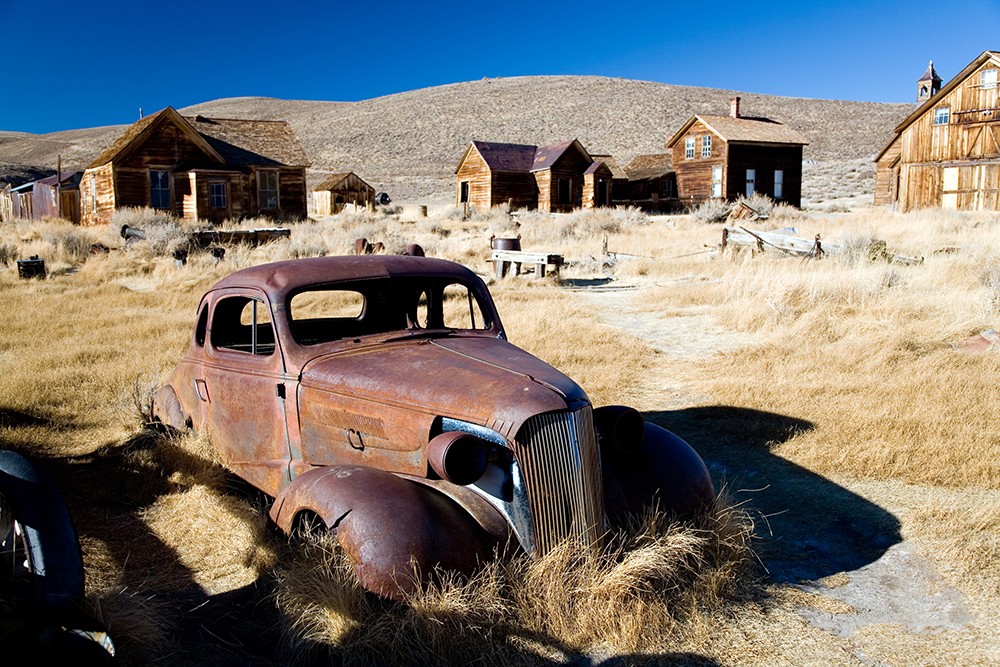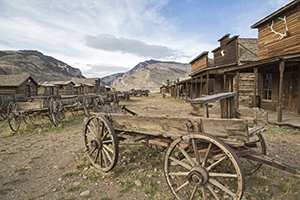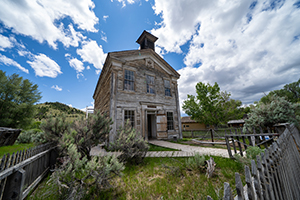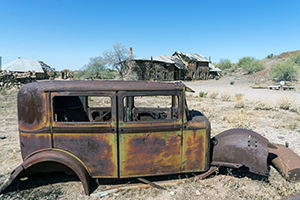
Take any stretch of famous Route 66 and Jim Hinckley can tell you just about every bush, corner and building in the area.
Hinckley has traversed the highway for nearly 40 years and compiled an impressive list of travel guides on his favorite subject--ghost towns.
 “Ghost towns have always had a fascination for people,” said Hinckley, author of Ghost Towns of Route 66. “There’s a romanticism associated with them.”
“Ghost towns have always had a fascination for people,” said Hinckley, author of Ghost Towns of Route 66. “There’s a romanticism associated with them.”
Sometimes it’s a yearning to understand our past. Sometimes it’s simple curiosity of how people lived and what they did and why they left. Sometimes it’s the Hollywood factor as if the spirit of Wyatt Earp may emerge at any moment.
Robust communities faced financial turmoil as their fortunes turned in an instant. Mines petered out. Some areas became targets for eminent domain and were converted to military bases. Or bureaucrats thousands of miles away established new highway routes that circumvented thriving towns.
“Politics plays a big part,” Hinckley said, recalling how new highways impacted small towns along Route 66. “The plan for Interstate 40 bypassed these old towns. They died in a few years when the business closed and most of the residents moved out.” 
Places like San Juan, New Mexico, felt the sting of rejection when Highway 40 sent speeding drivers north of the town. San Juan was part of the historic Santa Fe Trail, and it still evokes images of dusty trails for history buffs like Hinckley.
“Since I was a kid I always loved history and cars,” Hinckley said. “I saw this black and white picture of my grandfather Robert sitting on a front porch with Henry Ford, and that made me curious.”
Problem was, nobody in the family knew anything about the photo. The young Hinckley took it upon himself to dig for an answer. What he uncovered was a man swept into the rising tide of the automobile industry in nearby Detroit.
Southeastern Michigan of the early 1900 was the equivalent of today’s Silicon Valley. Hundreds of companies vied for a piece of the booming demand. The expanding supply chain--vehicle assembly houses, tire manufacturers, parts suppliers, engine manufacturers--catapulted America into the world’s top manufacturer and created a well-to-do class of entrepreneurs.
Grandpa Hinckley was among them. Born in Michigan a year after the Civil War ended, the elder Hinckley settled in a farming community of Jackson. The house was so big his two sons later converted it into a quadruplex building.
The elder Hinckley was an industrious tinkerer and worked as a machinist for auto pioneer David Buick. He also took out a patent on a coaster brake for bicycles, invested in real estate, established a tool factory and became a founding member of Hacket Automobile. His relationship to Henry Ford and the story of the mysterious photo remained unknown, however.
“Nobody in our family really knew,” Hinckley said. “But I loved cars and history ever since.”
Jim’s father, Robert, moved the family to Arizona in the 60s. Every year made the 2,000 mile drive from Arizona to the old farmhouse in Michigan via Route 66. Along the way they stopped at historic sites and abandoned towns.
 As an adult, Hinckley continued to follow in his father’s steps. He logged tens of thousands of highway miles working a variety of jobs and can recite all the landmarks he’s visited during the last four decades.
As an adult, Hinckley continued to follow in his father’s steps. He logged tens of thousands of highway miles working a variety of jobs and can recite all the landmarks he’s visited during the last four decades.
“I went through my John Wayne stage in the 1970s,” Hinckley said. “I worked as a ranch hand and explored old western towns.“The pay was brutal but it was the best job I ever had.”
At the time he also performed in rodeos throughout the Southwest. Traveling from show to show gave him an appreciation for the rich history of Arizona and New Mexico. He also discovered a serious disconnect between his long-term goals and life as a cowboy.
“I learned you don’t live very long doing that,” said Hinckley, who recalled how the gigs were fun but the mornings after were painful.
The budding wrangler traded stirrups for a pick and shovel. He worked briefly as a miner in underground and open pits. The dangerous work sent him deep into the earth where he learned the art of extracting precious minerals from volcanic rock.
The job paid a paltry wage and opened his eyes to the dangers of underground mining. He said he felt a kinship to laborers who flocked to small southwestern towns during the late 1800s and worked for large mining concerns. They used crude tools, worked long hours and lived paycheck-to-paycheck.
Places like Rholite, Nev., went from tent city in 1905 to a thriving metropolis within five years.
Its meteoric rise precipitated an equally steep decline as mines played out.
Within 15 years it became a ghost town. Remnants of the town still exist and were used in several movies including The Island, a 2004 film starring Ewan McGregor and Scarlett Johansson.
“It’s the boom and bust cycle,” Hinckley said. “It keeps me from taking life overly serious. You realize how fleeting things can really be.”
Hinckley replaced his miner’s helmet with a baseball cap and tractor-trailer rig. He joined for a national trucking firm and drove in a territory that included--what else?--Route 66. He was thrilled.
The gig gave Hinckley more opportunities for him to discover ghost towns and investigate their dimming history. Yet, life on the road didn’t fit his duties as a family man. 
Hinckley developed what he called “I” trouble.
“I couldn’t see any reason to put up with their demands,” Hinckley said. “And they couldn’t see any reason to put up with my attitude.”
So he left. Now he spends his days writing about vehicles and ghost towns. Hinckley has filled stacks of notebooks with names and dates and locations and events.
While each ghost town offered a unique story, Hinkcley unravelled a few common threads leading to their demise.
Mining towns never grew roots beyond their main employer. Once the mine played out, miners took their savings and their families elsewhere. The sudden change impacted everyone from the barber to the grocer. Schools were closed.
Farming communities suffered the same fate for different reasons, Hinckley explained. They had thriving main streets with stores, bars, banks and perhaps a gas station--along with slow speed limits and stop signs. The interstate highway system circumvented Main Street America and enabled drivers to get from Point A to Point B quickly.
“They were old towns but their demise was modern,” Hinckley said. “Improvements to Route 66 bypassed Glenrio, Texas, with Highway 40. Within a year the town was closed except for one bar.”
Hinckley appointed himself unofficial historian of ghost towns before their stories are lost to time. He continues traveling the side roads and looking for details of a past he says helps explain our culture.
“Some of the western ghost towns get all the attention,” Hinckley said, encouraging drivers to take a side road on their next road trip. “But ghost towns are everywhere.”
Article by Jay Alling, editor of Sensible Driver. Write to jay@sensibledriver.com.
Copyright © 2024 by Sensible Driver. All rights reserved.